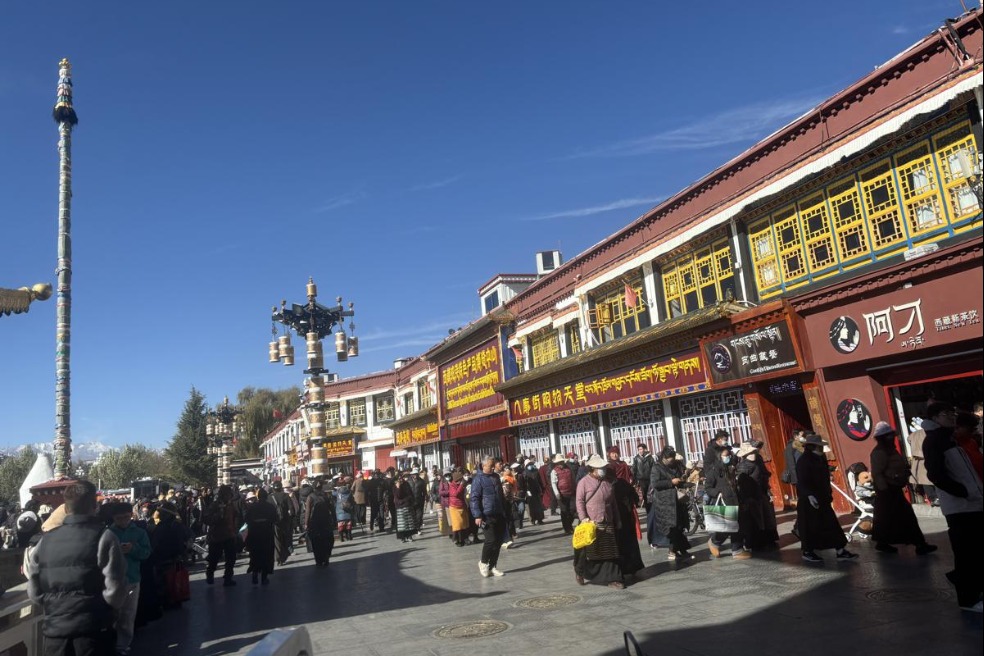Exhibition highlights early design innovation
Spotlight falls on man who inspired Britain's Arts and Crafts movement at the turn of the 20th century, Wang Linyan reports in London.

Curator Max Donnelly is glad that, after working for two and a half years, an exhibition introducing the British Arts and Crafts movement has opened in Nanjing, East China's Jiangsu province, this month.
Nanjing Museum is the first venue for Beyond William Morris — British Arts and Crafts 1890-1920.Its China tour, which will also include Hebei Museum, Chengdu Museum and two more venues, will run until 2025.
"I'm particularly excited to see the exhibition is opening in Nanjing, because I understand that it is one of the largest museums in China, and one of the oldest, celebrating 90 years this year," says Donnelly, curator of furniture and woodwork 1800-1915 at the Victoria and Albert Museum in London.
The exhibition explores the movement in Britain, which was inspired by renowned decorative art designer William Morris (1834-96), showcasing signature works by the most talented designers, craftspeople and manufacturers involved in the movement from 1890 to 1920.
The 100-plus exhibits, some of which are rarely seen in public, are carefully selected from the collections of the V&A Museum.
Visitors are able to see designs, wallpapers, textiles, furniture, ceramics, metalwork, jewelry and stained glass created by Morris and his daughter May, an embroidery designer and jeweler; English architects and designers C.F.A.Voysey and C.R. Ashbee; artist and book illustrator Walter Crane and Scottish architect and designer Charles Rennie Mackintosh, among others.
"It's the first time for the classic work of William Morris and his followers to be exhibited in China. I'm sure it will be an artistic feast for the eyes of Chinese visitors," says Tan Ping, director of Art Exhibitions China.
As President Xi Jinping, who is also general secretary of the Communist Party of China Central Committee, proposed the Global Civilization Initiative in March, Tan says, he stressed joint efforts to respect the diversity of world civilization, uphold common values of humanity, value cultural inheritance and creativity, and enhance international cultural exchanges and cooperation. The initiative is China's solution to promote the development of civilization and build a community with a shared future for mankind, he says.
"The exhibition is a key move for the Art Exhibitions China to implement the Global Civilization Initiative. It will play a key role in deepening cultural exchanges between China and the United Kingdom in the new era."
Beyond William Morris is the second V&A exhibition that Art Exhibitions China has introduced into China. The first was the exhibition of Masterpieces in Miniature (Treasures from the Rosalinde and Arthur Gilbert Collection), which was seen by nearly 1 million visitors across seven Chinese cities.
Nick Marchand, head of International Programmes at V&A, takes Beyond William Morris as a good example of the institution's history.
"We are excited about it connecting with new audiences in China, as well as the opportunity to visit cities and provinces we've not had the chance to take exhibitions to in the past," he says. "Nanjing Museum is a national-level museum in a city with a vibrant and lively student population. We're delighted to open the exhibition in Nanjing."
For Chen Li, a curator at the Nanjing Museum, the main challenges during the planning and design of the exhibition concern exhibit protection and lighting.
Many of the exhibits are designs and textiles, which are sensitive to light and can only be exposed to light level below 50 lux.
"To best protect the exhibits, a label with light box is especially designed to provide required light level for the exhibits as well as for visitors to be able to read," Chen says.
"During the setup, a Chinese lighting designer worked together with a representative from the V&A. As it's well-designed, everything went well."
Key work
Morris was among those who, along with John Ruskin, a famous English art critic during the Victorian era, helped formulate the ideas behind the movement, which revolved around the idea of the pleasure of making things, despite the Victorian era's focus on industrial progress.
But Morris was different, because he not only preached the message, he practiced it.
"Morris combined theory with practice," says Donnelly.
Morris founded his own company in 1861, which later became known as Morris & Co. It was important, because he employed both artists and makers to design and make things, including wallpaper, furniture, stained glass, textiles, interior and exterior decor and printing limited-edition books.
"It is a practical example of his encouragement of designers and craftspeople, which makes him a leading advocate," says Donnelly.
In the wake of Morris & Co's establishment, many firms offering similar services were established, and some existing firms opened workshops specializing in handmade products. This was in addition to the scores of workshops, guilds and other enterprises which operated on Arts and Crafts principles.
The proportion of Morris' work in the exhibition is modest, about 15 pieces out of roughly 125, but Donnelly says they are all significant works by Morris or by Morris& Co.
For example, there's an original Morris watercolor design for his Acanthus wallpaper, which is shown alongside the final printed product. Acanthus design and the Strawberry Thief textile pattern, which shows birds stealing strawberries, are among exhibits that demonstrate Morris' strength in using plants, flowers, birds and animals as inspiration.
Reviving craftsmanship is, arguably, the biggest contribution Morris made to the movement.
The printing block used to print the Strawberry Thief is exhibited next to a piece of the finished fabric to show the strong link between design, craft and production.
Another exhibit is the model carpet loom, which was used by Morris to teach people how to weave carpets.
"Morris presented it to the V&A himself. It's a really important object, as it helps people understand the production process and how he was directly involved in it," explains Donnelly. "He was very hands-on in teaching; he hoped to inspire people to make things."
Personal experience
Morris' personal experience shaped his views of machines, craftsmanship and aesthetics.
Born into a well-to-do family, Morris was able to spend a lot of his childhood learning and he loved nature. When he went to Oxford to study, he developed a great interest in the literature and romance of the past.
In 1851, when he was 17, the Great Exhibition opened in London. He refused to go to the exhibition citing grounds of taste.
He had a house built for himself and his wife Jane, an embroiderer, when they got married. When they were furnishing the house, they just couldn't find things that they liked. This was one of the reasons why he decided to try and create things himself, founding his own company that would produce decorations and make things as he wanted them to be made.
And that's where his journey started.
The birth of the Arts and Crafts movement signaled the beginning of a change in the value society placed on how things were made, according to an introduction on the V&A Museum website.
"The main characteristics of the movement are the focus on good design and skilled craftsmanship, whether that was one of handmade objects, of which there are many in the exhibition, or those made with the help of some kind of form of mechanization," explains Donnelly.
A good example of the movement is the buckle and belt tag by Henry Wilson (1864-1934), a beautiful piece of silver set with semiprecious stones, which has been taken especially out of the Jewellery Gallery of the V&A Museum for the China tour.
Wilson wanted to use polished stones, not cut stones, as was the fashion at the time, as the former are a bit smoother and "maintained more of the magical quality".
Donnelly says that Wilson is a good example of an Arts and Crafts designer, as he worked in different fields as an architect, sculptor, metalworker and jeweler, and he also taught people in his studio.
There's a design for a dish by English potter and tile designer William de Morgan (1839-1917) called Sea Birds' Island, which shows birds perched on a raft with a whale in the water. The paper has got little holes in it. That was part of the technique of transferring the design onto the ceramic before it was decorated. It's a good example because it shows a combination of design and craft, Donnelly continues.
In addition to commissioning designs, the manufacturers have also played a key part in creating arts and crafts, and adapting designs in the movement, which is not just about handmade objects, he adds.
Influence on China
While Donnelly mentions that Asian ceramics were also a source of inspiration for the artists at the time, Chen says that, when Morris' "contagious" ideas and work entered China through Japan in the early 20th century, Morris became one of the most well-known British cultural figures during that time.
"Chen Zhifo, a modern art educator, painter and designer, was so deeply inspired by Morris, as well as the Arts and Crafts movement in Britain, that he called for merging arts and crafts with industry and manufacturers to provide products that meet the needs of people's daily lives," Chen Li cites as an example.
Acclaimed Chinese artists and designers including Pan Xunqin, Lei Guiyuan and Zhang Guangyu were also inspired to design many classic works for commercial purposes, and publish relevant books, "laying the foundation for the development of modern architecture, furniture, interior design, graphic design and commercial art", says Chen Li.
The Arts and Crafts movement flourished at a time of great social and economic upheaval in Britain, when many people moved from the country into cities to find work, and their lives changed with industrialization. There's the feeling that people were living far from nature, and they were being torn from their roots; that's partly where this love of nature comes from, Donnelly says.
"So, if we think about that today, some of the things which people wanted to try and achieve during the movement are still things that we think about now," observes Donnelly.
"Some of the key elements of Arts and Crafts were fulfillment of life through meaningful work, an appreciation of beauty and a reverence for nature and the environment. Those things are just as important to craft workers, manufacturers and consumers today.
"By looking at how artists, designers and makers tackled those issues during the period when the Arts and Crafts movement flourished, it can give us some ideas and maybe some inspiration for today."
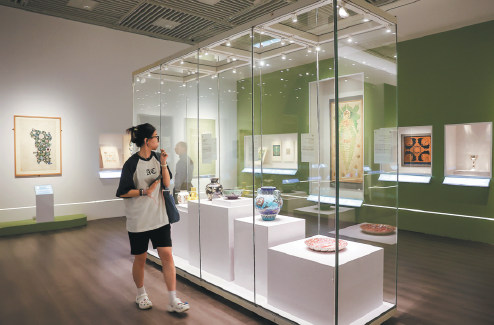
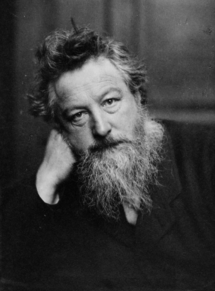


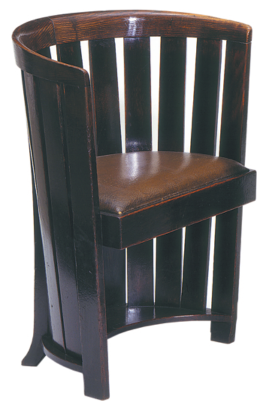

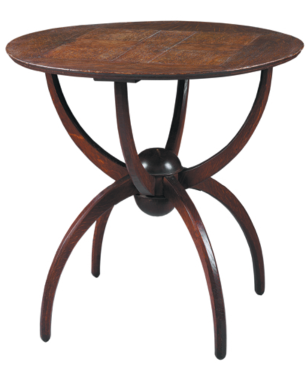
Today's Top News
- Judicial reform critical for modernizing governance
- Effective use of investment emphasized
- China's shuttle diplomacy strives to reach ceasefire
- Nanjing Museum's handling of donated art, relics being probed
- Key role of central SOEs emphasized
- New travel program hailed as 'milestone'



















